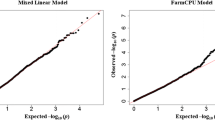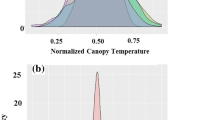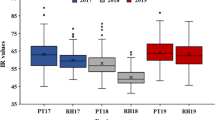Abstract
Rapid establishment of canopy coverage decreases soil evaporation relative to transpiration, improves water use efficiency and light interception, and increases soybean competitiveness against weeds. The objective of this study was to identify genomic loci associated with canopy coverage (CC). Canopy coverage was evaluated using a panel of 373 MG IV soybean genotypes that was grown in five environments. Digital image analysis was used to determine canopy coverage two times (CC1 and CC2) during vegetative development approximately 8 to 16 days apart for each environment. After filtration for quality control, 31,260 SNPs with a minor allele frequency (MAF) ≥ 5% were used for association mapping with the FarmCPU model. Analysis identified significant SNP-canopy coverage associations including 36 for CC1 and 56 for CC2. Five SNPs for CC1 and 11 SNPs for CC2 were present in at least two environments. The significant SNP associations likely tagged 33 (CC1) and 50 (CC2) different quantitative trait loci (QTLs). Eleven putative loci were identified in which chromosomal regions associated were coincident for CC1 and CC2. Candidate genes identified using these significant SNPs included those with reported functions associated with growth, developmental, and light responses. Favorable alleles from significant SNPs may be an important resource for pyramiding genes to improve canopy coverage and for identifying parental genotypes for use in breeding programs.

Similar content being viewed by others
References
Allen RG, Pereira LS, Raes D, Smith M (1998) Crop evapotranspiration: guidelines for computing crop water requirements. Irrigation and Drainage Paper No. 56, Food and Agriculture Organization of the United Nations, Rome, Italy
Bondari K (2003) Statistical analysis of genotype × environment interaction in agricultural research. In: Paper SD15, SESUG. The Proceedings of the SouthEast SAS Users Group, St Pete Beach
Bussan AJ, Burnside OC, Orf JH, Ristau EA, Puettmann KJ (1997) Field evaluation of soybean (Glycine max) genotype for weed competitiveness. Weed Sci 45:31–37
Campillo C, Prieto MH, Daza C, Moñino MJ, García MI (2008) Using digital images to characterize canopy coverage and light interception in a processing tomato crop. Hort Science 43:1780–1786.35
Clauw P, Coppens F, De Beuf K, Dhondt S, Van Daele T, Maleux K, Storme V, Clement L, Gonzalez N, Inzé D (2015) Leaf responses to mild drought stress in natural variants of Arabidopsis. Plant Physiol 167:800–816
De Bruin JL, Pedersen P (2008) Soybean seed yield response to planting date and seeding rate in the upper Midwest. Agron J 100:696–703
Dhanapal AP, Ray JD, Singh SK, Hoyos-Villegas V, Smith JR, Purcell LC, King CA, Fritsch FB (2015a) Association mapping of total carotenoids in diverse soybean genotypes based on leaf extracts and high-throughput canopy spectral reflectance measurements. PLoS One 10(9):e0137213
Dhanapal AP, Ray JD, Singh SK, Hoyos-Villegas V, Smith JR, Purcell LC, King CA, Cregan PB, Song Q, Fritsch FB (2015b) Genome-wide association study (GWAS) of carbon isotope ratio (δ13C) in diverse soybean [Glycine max (L.) Merr.] genotypes. Theor Appl Genet 128:73–91
Edward JT, Purcell LC, Karcher DE (2005) Soybean yield and biomass responses to increasing plant population among diverse maturity groups. II Light interception and utilization Crop Sci 45:1778–1785
Edwards JT, Purcell LC (2005) Soybean yield and biomass responses to increasing plant population among diverse maturity groups: I Agronomic characteristics. Crop Sci 45:1770–1777
Fickett ND, Boerboom CM, Stoltenberg DE (2013) Soybean yield loss potential associated with EarlySeason weed competition across 64 site-years. Weed Sci 61:500–507
Fiorani F, Rascher U, Jahnke S, Schurr U (2012) Imaging plants dynamics in heterogenic environments. Curr Opin Biotech 23:227–235
Gaspar AP, Conley SP (2015) Responses of canopy reflectance, light interception, and soybean seed yield to replanting suboptimal stands. Crop Sci 55(1):377–385
Gifford RM, Thorne JH, Hitz WD, Giaquinta RT (1984) Crop productivity and photoassimilate partitioning. Science 225:801–808
Green JM, Owen MDK (2011) Herbicide-resistant crops: utilities and limitations for herbicide resistant weed management. J Agric Food Chem 59:5819–5829
Hao D, Cheng H, Yin Z, Cui S, Zhang D, Wang H, Yu D (2012) Identification of single nucleotide polymorphisms and haplotypes associated with yield and yield components in soybean (Glycine max) landraces across multiple environments. Theor Appl Genet 124:447–458
Hwang E, Song Q, Jia G, Specht JE, Hyten DL, Costa J, Cregan PB (2014) A genome-wide association study of seed protein and oil content in soybean. PLoS Genet 15:1
Jannink JL, Orf JH, Jordan NR, Shaw RG (2000) Index selection for weed suppressive ability in soybean. Crop Sci 40:1087–1094
Jannink JL, Jordan NR, Orf JH (2001) Feasibility of selection for high weed suppressive ability in soybean: absence of tradeoffs between rapid initial growth and sustained later growth. Euphytica 120:291–300
Kaler AS, Dhanapal AP, Ray JD, King CA, Fritsch FB, Purcell LC (2017a) Genome-wide association mapping of carbon isotope and oxygen isotope ratios in diverse soybean genotypes. Crop Sci 57:3085–3100
Kaler AS, Ray JD, King CA, Schapaugh WT, Purcell LC (2017b) Genome-wide association mapping of canopy wilting in diverse soybean genotypes. Theor Appl Genet 130:1–15
Karcher DE, Richardson MD (2005) Batch analysis of digital images to evaluate turfgrass characteristics. Crop Sci 45:1536–1539
Liebisch F, Kirchgessner N, Schneider D, Walter A, Hund A (2015) Remote, aerial phenotyping of maize traits with a mobile multi-sensor approach. Plant Methods 11:9
Liu X, Huang M, Fan B, Buckler ES, Zhang Z (2016) Iterative usage of fixed and random effect models for powerful and efficient genome-wide association studies. PLoS Genet 12(2):e1005767
Manandhar A, Sinclair TR, Rufty TW, Ghanem ME (2017) Leaf emergence (phyllochron index) and leaf expansion response to soil drying in cowpea genotypes. Physiol Plantarum 160:201–208
McCarthy MI, Abecasis GR, Cardon LR, Goldstein DB, Little J, Ioannidis JPA, Hirschhorn JN (2008) Genome-wide association studies for complex traits: consensus, uncertainty and challenges. Nature Rev Genet 9(5):356–369
Money D, Gardner K, Migicovsky Z, Schwaninger H, Zhong GY, Myles S (2015) LinkImpute: fast and accurate genotype imputation for non-model organisms. G3 5(11):23383–22390
Nordborg M, Tavaré S (2002) Linkage disequilibrium: what history has to tell us. Trends Genet 18(2):83–90
Place GT, Reberg-Horton SC, Dickey DA, Carter TE (2011a) Identifying soybean traits of interest for weed competition. Crop Sci 51:2642–2654
Place GT, Reberg-Horton SC, Carter TE, Smith AN (2011b) Effects of soybean seed size on weed competition. Agron J 103:175–181
Purcell LC (2000) Soybean canopy coverage and light interception measurements using digital imagery. Crop Sci 40:834–837
Purcell LC, Specht JE (2004) Physiological traits for ameliorating drought stress. In: Boema HR, Specht JE (eds) Soybeans: improvement, production, and uses. 3rd ed. Madison, WI: American Society of Agronomy. Pp, pp 569–620
Purcell LC, Edwards JT, Brye KR (2007) Soybean yield and biomass responses to cumulative transpiration: questioning widely held beliefs. Field Crop Res 101:10–18
Ray JD, Dhanapal AP, Singh SK, Hoyos-Villegas V, Smith JR, Purcell LC, King CA, Boykin D, Cregan PB, Song Q, Fritschi FB (2015) Genome-wide association study of ureide concentration in diverse maturity group IV soybean [Glycine max (L.) Merr.] accessions. G3 5(11):2391–2403
Rebetzke GJ, Ellis MH, Bonnett DG, Richards RA (2007) Molecular mapping of genes for coleoptile growth in bread wheat (Triticum aestivum L.) Theor Appl Genet 114:1173–1183
Richards RA, Watt M, Rebetzke GJ (2007) Physiological traits and cereal germplasm for sustainable agricultural systems. Euphytica 154:409–425
Risch N, Merikangas K (1996) The future of genetic studies of complex human diseases. Science 273(5281):1516–1517
SAS Institute (2013) The SAS system for Windows. Version 9.3. SAS Inst. Inc., Cary, NC
Shaner DL (1995) Herbicide resistance: where are we? How did we get here? Where are we going? Weed Technol 9:850–856
Slafer GA, Araus JL, Royo C, Garcia Del Moral LF (2005) Promising eco-physiological traits for genetic improvement of cereal yields in Mediterranean environments. Ann Appl Biol 146:61–70
Song Q, Hyten DL, Jia G, Quigley CV, Fickus EW, Nelson RL, Cregan PB (2013) Development and evaluation of SoySNP50K, a high-density genotyping array for soybean. PLoS One 8(1):e54985
Tardieu F, Tuberosa R (2010) Dissection and modelling of abiotic stress tolerance in plants. Curr Opin Plant Biol 13:206–212
Tuberosa R, Salvi S, Giuliani S, Sanguineti MC, Bellotti M, Conti S, Landi P (2007) Genome-wide approaches to investigate and improve maize response to drought. Crop Sci 47:120–141
Wen Z, Tan R, Yuan J, Bales C, Du W (2014) Genome-wide association mapping of quantitative resistance to sudden death syndrome in soybean. BMC Genomics 15:809
Xavier A, Hall B, Hearst AA, Cherkauer KA, Rainey KM (2017) Genetic architecture of phenomic-enabled canopy coverage in Glycine max. Genetics 206:1081–1089. https://doi.org/10.1534/116.198713
Yu J, Pressoir G, Briggs WH, Vroh BI, Yamasaki M, Doebley JF, McMullen MD, Gaut BS, Nielsen HJB, Kresovich S, Buckler ES (2006) A unified mixed-model method for association mapping that accounts for multiple levels of relatedness. Nat Genet 38:203–208
Zhang J, Song Q, Cregan PB, Nelson RL, Wang X, Wu J, Jiang GL (2015) Genome-wide association study for flowering time, maturity dates and plant height in early maturing soybean (Glycine max) germplasm. BMC Genomics 16:217. https://doi.org/10.1186/s12864-015-1441-4
Zhu C, Gore MA, Buckler ES, Yu J (2008) Status and prospects of association mapping in plants. Plant Genome 1:5–20
Acknowledgements
The authors gratefully acknowledge partial funding of this research from the United Soybean Board. Mention of trade names or commercial products in this publication is solely for the purpose of providing specific information and does not imply recommendation or endorsement by the US Department of Agriculture. The USDA is an equal opportunity provider and employer.
Author information
Authors and Affiliations
Corresponding author
Rights and permissions
About this article
Cite this article
Kaler, A.S., Ray, J.D., Schapaugh, W.T. et al. Association mapping identifies loci for canopy coverage in diverse soybean genotypes. Mol Breeding 38, 50 (2018). https://doi.org/10.1007/s11032-018-0810-5
Received:
Accepted:
Published:
DOI: https://doi.org/10.1007/s11032-018-0810-5




